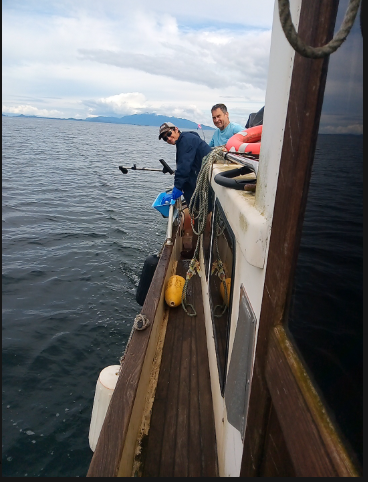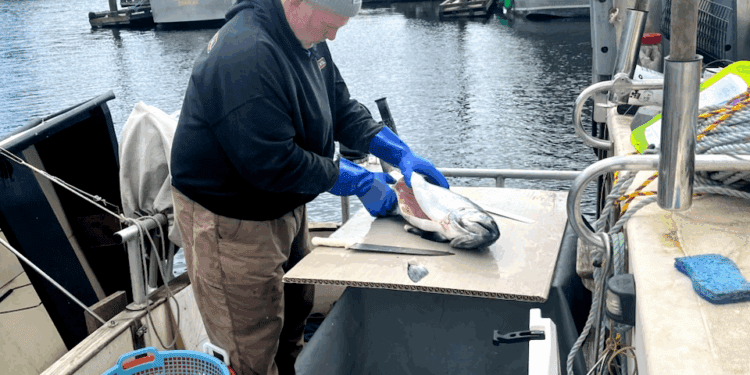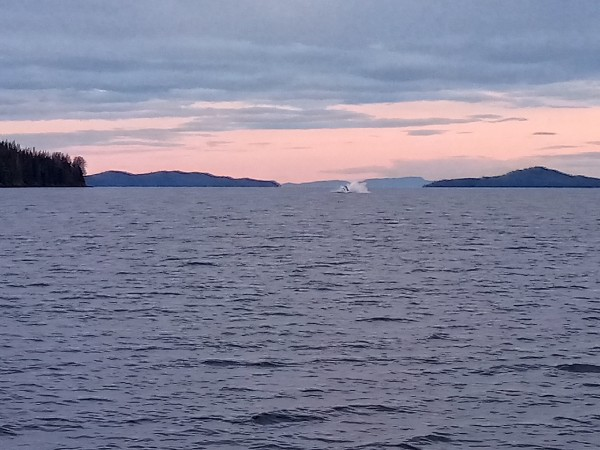Tom and Jasper (aka, The Cheese, from his primary sustenance: string cheese) arrived 45 minutes early from Ketchikan. Luckily, I had gone out early to drink coffee on DJs porch. I heard a plane arrive as I entered the cafe, and saw Tom and Jasper exit the plane when I came out.
We headed straight for the boat and were soon idling out of north cove past all the seiners in town between fishing periods. The boys have been here many times, and were ready to go straight away.
We reached my favorite spot 2 hours later and put the lines out. We got a couple cohos, then put out the skate, and went in to anchor. Jasper took the kayak to the beach to look at rocks. Tom and I had salmon and salad for dinner. Jasper had pasta.
The next morning, there was nothing on the skate. We started trolling about 6 am. We caught a couple coho in the morning. After telling my college friend Scott in Ketchikan I hadn’t seen many pink salmon yet here just a day or two ago, well, they were here now. Near high tide, we found some fish. Cohos and pinks. And the pinks were plump, like the coho and kings this year. We quit fishing in the early afternoon with coho, a few pinks, and a rockfish. Jasper was off in the kayak to beach comb after we took care of the fish. Tom went to the beach later. I took a short nap and got up about 7 pm. By then, both boys had gone down for their own nap. I waited til 745 pm, and realized both boys were out cold, so I made the table into my bed and called it a day without making dinner.
On day three, we had enough cohos for the day by early afternoon, so I said let’s go check out Kelly Cove. We steamed an hour to get there. Two big seine tenders were anchored near the entrance as we steamed by to anchor after setting the skate. Then we took the punt and kayak to the beach.

I expected to find remains of a fish plant or something up from the beach, but we saw nothing man-made. There’s old dock pilings, a grave stone like you’d see in a cemetery for someone on the beach rocks, and an old mini sort of silo on a little cliff up from the beach, so something was once there. Maybe all the infrastructure other than the silo was on the dock that was once on the pilings. We had rockfish and salad for dinner. Jasper had pasta and popcorn. We turned in early, as usual. A seiner joined us in the anchorage about 1125 pm, and another at 1 am, after they off-loaded to the tenders.
We were up at sunrise the next day, as usual. The seiners were already gone fishing. We caught a chicken halibut on the skate, than put the gear out for salmon. By mid-morning, we’d caught only one coho, but also a couple lingcod and a big black rockfish.
We ran about an hour to my new favorite coho spot that I tried this year when the strong NW winds prevented us from fishing my regular haunts. By 230 pm, we had all the cohos we wanted, and called it a day. We set the skate, then anchored behind the pine Islands, and took care of our fish. We beach combed the beach there, and found lots of stuff. Buoys. Black mesh fencing. A sea otter skull. Jasper had the best find – a flasher (which doesn’t float) had floated in because it was attached to a commercial troll J-plug (which does float).
On day 5, we checked the skate a little after sunrise and caught a nice 37 lb halibut. We ran back to the coho spot, put on Jasper’s found flasher, and fishing was steady with it all morning. We trolled right along the beach, while two commercial trollers fished the deeper water just outside of us, so it was nice to have some body guards to protect us from a mob that could descend on us and mooch, which makes trolling a challenge in the same water. By about noon, we had our share of cohos for the day, and the cooler was full. We headed to town.
We butchered the day’s catch at the harbor stall, and headed home to get the fish into the freezer. Everyone got a shower. I made fresh salmon for dinner for Tom and I, and gave the Cheese step by step instructions on how to cook his pasta in the instant pot. We watched an eagle a good distance from the shore on the water in front of the cabin rowing with its wings to the shore with something it killed.
The next day, I awoke to both my fisherman down with COVID, it seems, so we laid low. I had them go through all the fishing reels that Sara and I found in the dumpster earlier in the summer to take any they wanted, as several of the reels are bass casting kinda reels I’d never use here, but would work well in in Iowa.
Today, we were up a little after 6 am. I got to packing their two boxes of fish about 7 am, and we were done at 8 am. We got to the airport, and Tom and Jasper got in line while I walked over to DJs to get coffee. When the boys got up to the counter, I walked in to see the box weights: only about 44 lbs each. Dang it! I’d added the weights up wrong for the boxes! I weigh the fish as I put them into the box, and I accounted for the box weight in the total weight twice. For each box!

Each box should have weighed just under 50 lbs, and I pride myself on getting it within a pound or less to that. Tom is never gonna let me live that down. This Getting Old is getting old.



















